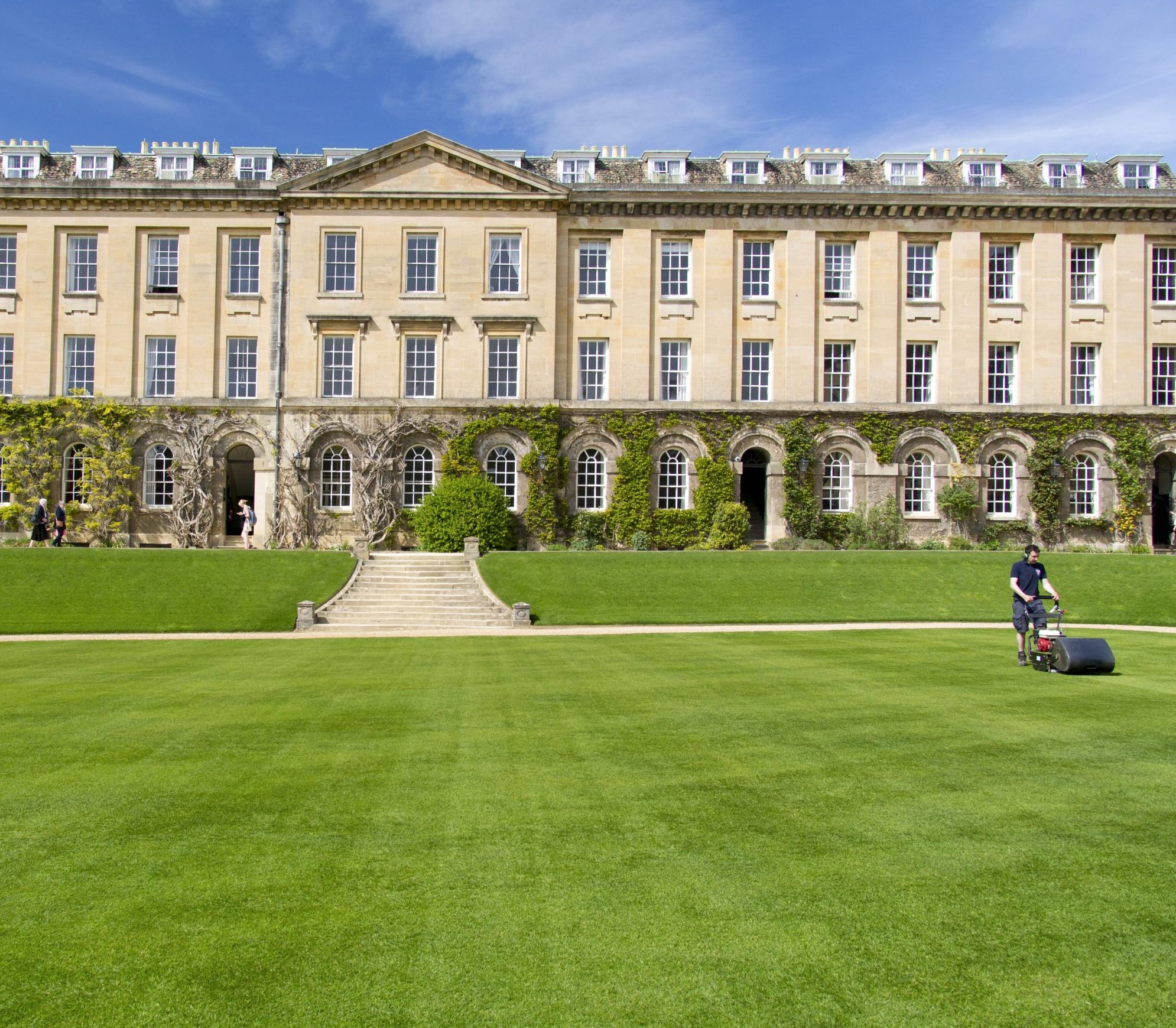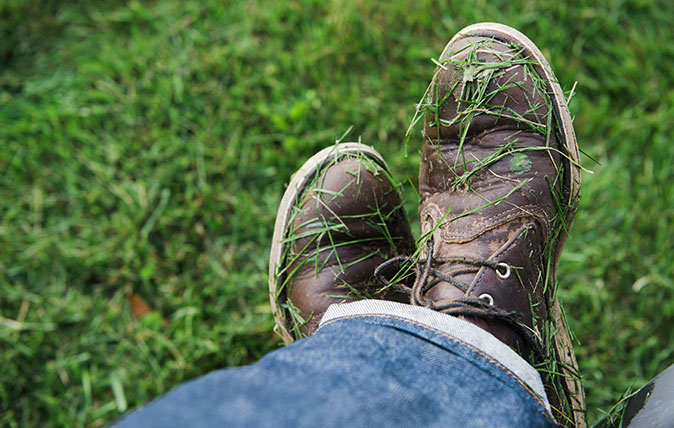Charles Quest-Ritson: 'Our beautiful lawns are the envy of the world... and the idea of rewilding your garden is nonsense'
The neat stripes of British gardens, such as Rockcliffe Garden in Gloucestershire, are an art form that is admired across the world and weeds have no place there.


There is an old story about the head gardener at one of the Oxford colleges talking to an American tourist who greatly admired the fine fescues and lawnmower stripes of the quads. How did he manage to create such a beautiful sward? Well, said the Englishman, you just mow it and mow it... for 500 years.
This came to mind last month when I saw a picture of ‘the wildflower meadow’ at King’s College, Cambridge. I was horrified to think that so many centuries of endeavour had been kicked over in the pursuit of such a worthless fad. Moreover, the caption explained, the meadow was being cut ‘using the wildlife-friendly method of Shire horses’. Perhaps they thought that dollops of fresh manure were worth the damage caused by the horses’ hoofs.
Wildlife meadows are artificial creations. You buy a mix of flower seed that is said to be suitable to your soil. Often, it includes species with pretty flowers that are not even native to Britain.
"A wildlife meadow is a perfectly legitimate horticultural undertaking. What is not acceptable is opting to destroy a feature that defines the character and importance of an established garden... Change is welcome, but not at the expense of destroying better things."
More often than not, the result is different from your expectations. Half the species seem not to germinate, so you buy a richer mix the following year — and that doesn’t work either. Wildlife meadows are a waste of money; I have never seen a pretty one. Ask the owners — they usually say how difficult it is to establish the right balance and make the meadow of their dreams.
But that’s not the point. A wildlife meadow is a perfectly legitimate horticultural undertaking. What is not acceptable is opting to destroy a feature that defines the character and importance of an established garden. Digging up a centennial college lawn is one example; so is cutting down ancient topiary or uprooting rare plants. We have a duty to conserve whatever we inherit of cultural value. Change is welcome, but not at the expense of destroying better things.
Our beautiful lawns are the envy of the world. The neat stripes produced by a traditional cylinder mower are universally admired. You see this art form worked to its highest levels by professional groundsmen on bowling greens, cricket squares, lawn-tennis courts and golf greens, but it is also popular among the owners (mainly men) of smaller gardens. I say ‘smaller’, because once you have a larger area to maintain you graduate to a garden tractor, whereupon you cease to have lawns and only have grass.
But the anti-lawn movement is part of a greater trend towards rewilding. That’s all very well if you want to create a nature reserve — the idea of letting 200 acres of farmland go to ruin has its supporters, although many would regret the despoliation of so many generations of good husbandry — but the idea of rewilding your garden is nonsense.
Exquisite houses, the beauty of Nature, and how to get the most from your life, straight to your inbox.
It goes against the whole construct of gardening, which requires the creation of an artificial environment to raise and enjoy the plants of your choice. Gardens exist to grow beautiful plants (most of them non-native and improved forms) and useful fruit and vegetables. Their beauty and usefulness cannot be compromised by super-competitive native plants (meaning weeds).
Proper gardeners abhor the fashion for growing thistles and willowherb, whether or not they’re wonderful for butterflies (or bees or wasps or horse-flies or something). The world is full enough of wildflowers in the wild. And that is the right place for them. There are plenty of nettles outside your garden — quite enough to keep your peacock and red admiral butterflies in fodder.
"Something is going seriously wrong when the RHS gives a gold medal — at its Tatton show in July — to a garden of weeds. The excuse for this disgraceful jumble of unwelcome plants is that ‘native plants are not just beautiful but essential for wildlife’. Yes, we know that. But the proper place for weeds is outside the garden."
Rewilding is not the same thing as naturalising. Gardeners are thrilled when a suitable plant makes itself at home and starts to spread. Nothing is more exciting than swarms of cyclamen in a churchyard or a woodland filled with snowdrops as far as the eye can see.
Cyclamen and snowdrops are foreign introductions — gardening is all about successful immigration — and, of course, there are native plants such as cornflowers, primroses and wild daffodils that we encourage to grow in our gardens, but we need to discriminate between good and bad ones.
Bindweed, wild garlic and ragwort are native plants with beautiful flowers, but their place is not in the garden. This is a lesson we need to teach the Royal Horticultural Society (RHS), to which many of us belong. It was founded (as the Horticultural Society of London) more than 200 years ago to encourage garden owners and improve their gardens.
There are many ways in which it fulfils its aims, through plant trials, shows and publications. But something is going seriously wrong when the RHS gives a gold medal — at its Tatton show in July — to a garden of weeds.
The excuse for this disgraceful jumble of unwelcome plants is that ‘native plants are not just beautiful but essential for wildlife’. Yes, we know that. But the proper place for weeds is outside the garden.
If the RHS won’t stick up for proper horticulture and the thousands of beautiful plants we grow in our gardens, what hope is there for gardening in years to come?

Should you mow your lawn?
Monty Don ruffled a few feathers recently when suggesting that we should just let our grass grow as long as

Credit: Alamy
Curious Questions: Why does freshly-mown grass smell so good?
Nothing says 'Spring is here' better than that wonderful aroma of newly-cut lawn. Martin Fone, author of 'Fifty Curious Questions',

Credit: Jacky Parker Photography via Getty
Alan Titchmarsh: 'I share my patch with all manner of animals, birds, bees and butterflies, and creepy-crawlies — they have every right to be there, but so do I'
We should stop beating ourselves up and cultivate responsibly for wildlife and the environment, but also enjoy the pleasure of
Charles Quest-Ritson is a historian and writer about plants and gardens. His books include The English Garden: A Social History; Gardens of Europe; and Ninfa: The Most Romantic Garden in the World. He is a great enthusiast for roses — he wrote the RHS Encyclopedia of Roses jointly with his wife Brigid and spent five years writing his definitive Climbing Roses of the World (descriptions of 1,6oo varieties!). Food is another passion: he was the first Englishman to qualify as an olive oil taster in accordance with EU norms. He has lectured in five languages and in all six continents except Antarctica, where he missed his chance when his son-in-law was Governor of the Falkland Islands.
